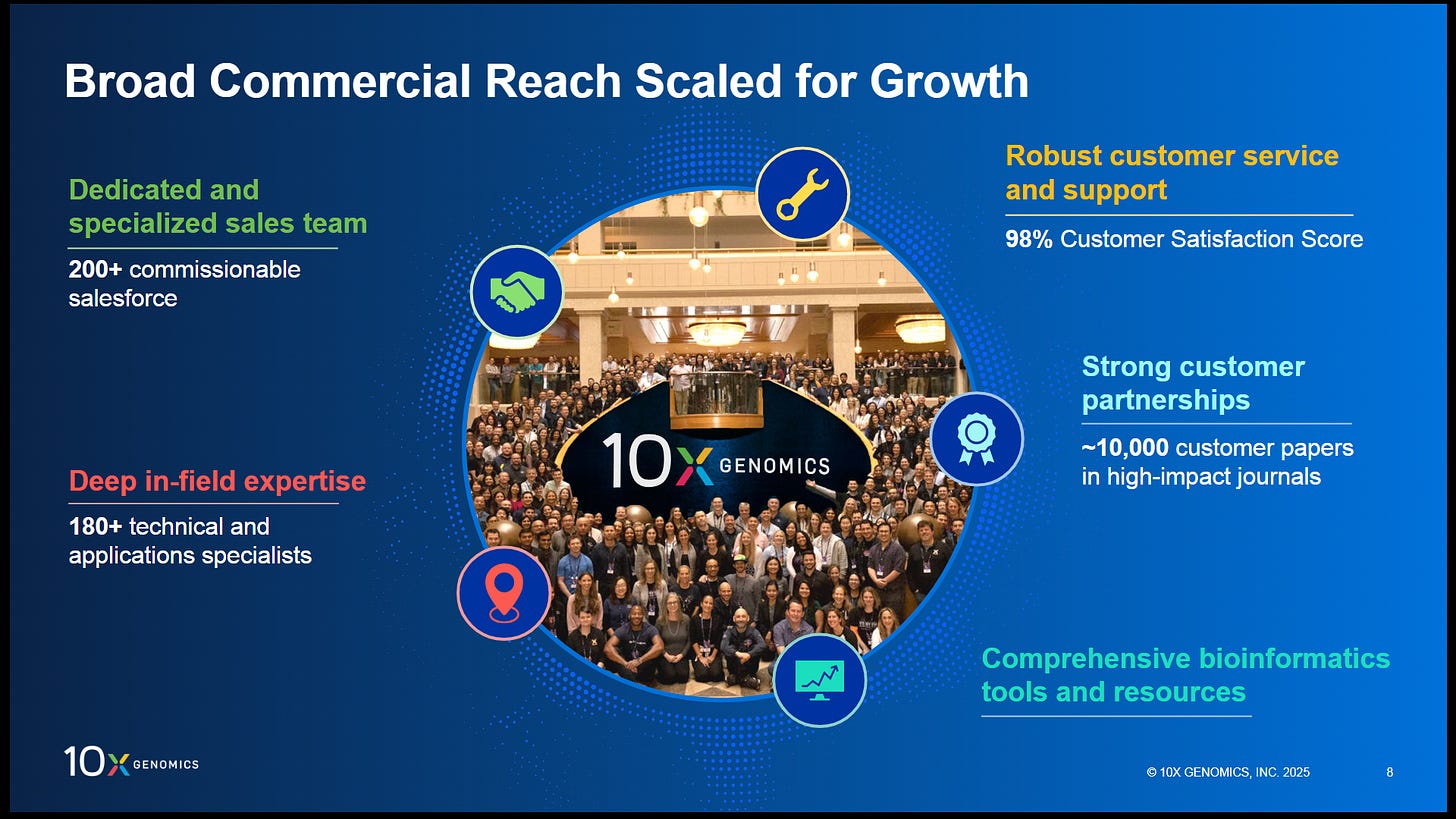JPM25: 10X Genomics $TXG
First of the JPM25 posts, these will be coming fast and frequently in the next 48-72 hours, so I’ll write a meta-post first with all the links and then not send emails for each individual ones.
Summary
10X Genomics is a biotechnology company specializing in the development of advanced genomic technologies and tools to accelerate scientific research. The company is known for its innovative solutions in single-cell and spatial biology, enabling researchers to gain unprecedented insights into complex biological systems.
10X Genomics has three main product lines:
Chromium: A platform for single-cell and multiomics analysis, providing high-resolution insights into gene expression, chromatin accessibility, immune profiling, and more.
Visium: A spatial genomics platform that allows researchers to visualize gene expression data in the context of tissue architecture, providing spatial resolution to transcriptomic studies.
Xenium: A platform for spatially resolved in situ analysis, combining high-throughput imaging with molecular profiling to enable subcellular resolution of biological systems.
By integrating these technologies, 10X Genomics supports discoveries across a wide range of applications, including oncology, immunology, and neuroscience.
10X Genomics (TXG) is one of the most innovative and well-established companies in the field of multi-omics: a step beyond pure genomics, where the products interrogate cell types, tissues and more. The human body is a very complex biological system, with 40 trillion cells and hundreds of different cell types. Even within a tissue, we see a large diversity of cells and cell types.
Here there is an analogy between “Bulk RNAseq”, which is a lab assay we’ve been doing for the better part of 10-20 years now, which measures mixtures which miss the underlying biology, here shown as a pile of crushed cars. Single Cell Analysis is equivalent to compiling the parts list of human biology, here shown with a dissassembled car with 4 wheels, a gear box, 4 break pads, the seats, etc. Finally, the Spatial Analysis allows to understand how the parts fit together, here showing a transparent car with the interior of the components of the motor and how they are physically placed in relation to each other.
The instruments, consumables and software that TXG provides allow the customers to measure biology at large scale and unprecendented resolution. Chromium is how things started, and more recently Visium and Xenium are adding the Spatial Biology side of capabilities to the TXG product line.
The company started not in multi-omics but in pure genomics with their 2015 “Linked Reads” product, using the microfluidic and barcoded beads technology that is at the basis of most of their products these days. Then scRNAseq (3’GEX) came out as a standardized commercial offering equivalent to the handful of academic offerings to assay single cells. The robustness and commercial support of the Chromium changed the landscape, which has placed TXG as the main player since then. In 2017, TXG added Immune Profiling with their 5’GEX product, which is still a unique offering that almost no other competitor has been able to offer. In 2018, the company added Epigenetics and Proteomics to the Chromium line, more feathers to the cap for the Chromium line. It was in 2019 when the Spatial Biology product line started, with Visium v1 (low resolution version) for poly-A mRNA molecules on a fresh frozen biopsy sample. In 2022, the company came up with Xenium, the first non-NextGenSequencing based assay, rather using an imaging-based approach to detect RNAs and proteins in a biopsy sample (fixed samples, e.g. FFPE biopsies). In the last two years, the company has iterated over those 3 product lines, with new versions with faster/cheaper/more complete outcomes (GEM-X or Xenium 5K panel), more sample types and more automation capabilities.
In commercial terms, the company had a fast initial growth, but the 2022 post-COVID19 hyperinflationary years did hurt their growth. The results that they presented today are a good positive sign of a recovery phase starting now.
The rapid growth of the company could have come with growing pains, and I think it’s fair to say that some of them were experienced by their customers, but considering how quickly the company itself grew, they’ve done very well in this regard.
Below I’ll continue with the presentation, including the Preliminary 2024 Results, and what I think is in store for TXG from now on.









